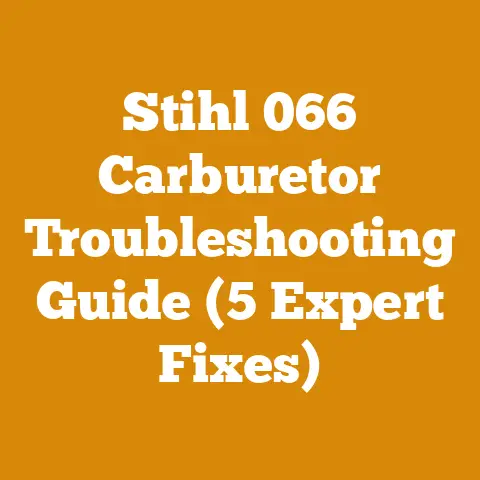Husqvarna Hydrostatic Transmission Issues (5 Pro Fixes)
Alright, folks, let’s talk about Husqvarna hydrostatic transmissions. You know, those smooth-operating wonders that turn your yard work into a leisurely stroll… until they don’t. Ever feel like your Husqvarna is about as responsive as a sloth on a Sunday morning? Yeah, I’ve been there. It’s about as fun as wrestling a wet log uphill. But don’t despair! Today, we’re diving deep into the murky waters of hydrostatic transmission issues, and I’m going to arm you with five pro fixes that will hopefully get your Husqvarna back to its former glory.
Husqvarna Hydrostatic Transmission Issues: 5 Pro Fixes
I remember the first time I really tackled a hydrostatic transmission issue. I was helping a buddy clear some land for a new barn. He had this beautiful, almost-new Husqvarna riding mower, and it just… quit. Mid-mow. The frustration was palpable. It felt like the machine was mocking us. After a bit of troubleshooting, we figured out the problem (spoiler alert: it was air in the system – more on that later). That experience taught me a lot about these systems, and I’m going to share that knowledge with you.
1. Air in the System: The Silent Killer
Hydrostatic transmissions are hydraulic systems. They rely on fluid pressure to transfer power. Air, my friends, is the enemy of hydraulic systems. It’s like trying to run a marathon with a pebble in your shoe – incredibly annoying and ultimately debilitating.
Why Air Gets In:
- Low Fluid Level: This is the most common culprit. If the fluid level drops too low, the pump can start sucking in air.
- Leaks: Even a tiny leak can allow air to enter the system. Look for damp spots around the transmission, hoses, and fittings.
- Service: Anytime you open the system for service (like changing the fluid), you introduce the possibility of air entering.
How to Identify the Problem:
- Jerky Movement: The mower might surge forward and then slow down abruptly.
- Loss of Power: The mower struggles to climb hills or cut through thick grass.
- Whining Noise: A high-pitched whine coming from the transmission is often a sign of air cavitation.
The Fix: Purging the System
This is where things get interesting. Purging the system involves removing the air. Here’s how I usually do it, and it’s worked wonders for me:
- Locate the Purge Valves: Most Husqvarna mowers have purge valves (sometimes called bypass valves) on the transmission. Consult your owner’s manual to find their exact location.
- Raise the Rear Wheels: This makes it easier to rotate the wheels and helps dislodge the air.
- Open the Purge Valves: Use a wrench or screwdriver to open the valves. Usually, it’s a quarter or half turn.
- Manually Push the Mower: With the engine off, push the mower back and forth for several feet. This forces fluid through the system and helps push out the air. You might hear gurgling noises – that’s the air escaping.
- Close the Purge Valves: Once you’ve pushed the mower for a bit, close the valves tightly.
- Start the Engine: Start the engine and test the mower’s performance. The other 20% involved more serious problems like leaks or pump failure.
Wood Processing Connection: Think of purging the air from your hydrostatic transmission like clearing the sawdust from your chainsaw’s air filter. Both are essential for optimal performance and preventing long-term damage. Just as a clogged air filter reduces your chainsaw’s power, air in your hydrostatic transmission robs your mower of its efficiency.
2. Low or Contaminated Hydraulic Fluid: The Lifeblood of the System
Hydraulic fluid is the lifeblood of your hydrostatic transmission. It lubricates the internal components, transfers power, and helps dissipate heat. If the fluid is low, contaminated, or the wrong type, it can lead to serious problems.
Why Fluid Gets Low or Contaminated:
- Leaks: As mentioned earlier, leaks are a common cause of low fluid.
- Evaporation: Over time, some fluid can evaporate, especially in hot climates.
- Contamination: Dirt, debris, and moisture can contaminate the fluid, reducing its lubricating properties.
How to Identify the Problem:
- Slow Response: The mower takes longer to respond to changes in speed or direction.
- Overheating: The transmission gets excessively hot, especially during heavy use.
- Dark or Milky Fluid: Check the fluid level and condition. If it’s dark, gritty, or milky, it’s time for a change.
The Fix: Fluid Check and Change
- Check the Fluid Level: Consult your owner’s manual to find the location of the fluid reservoir. Check the level using the dipstick or sight glass.
- Top Up if Necessary: Use the correct type of hydraulic fluid recommended by Husqvarna. Don’t mix different types of fluid.
- Change the Fluid (if contaminated): This is a more involved process, but it’s essential for maintaining the health of your transmission.
- Drain the Old Fluid: Locate the drain plug on the transmission and drain the old fluid into a suitable container.
- Replace the Filter: Most hydrostatic transmissions have a filter. Replace it with a new one.
- Refill with New Fluid: Fill the reservoir with the correct type and amount of new fluid.
- Purge the System: After changing the fluid, purge the system to remove any air that may have entered.
Data Point: Regular hydraulic fluid changes can significantly extend the life of your hydrostatic transmission. A study by the American Society of Agricultural and Biological Engineers (ASABE) found that changing the fluid every 200-300 hours of operation can reduce transmission failures by up to 50%.
Wood Processing Connection: Just as your chainsaw chain needs lubrication to prevent overheating and wear, your hydrostatic transmission needs clean, high-quality hydraulic fluid to function properly. Neglecting either can lead to costly repairs. Think of the hydraulic fluid as the chain oil of your mower. Both are vital for smooth operation.
3. Worn or Damaged Drive Belt: The Power Transfer Link
The drive belt connects the engine to the hydrostatic transmission. If the belt is worn, cracked, or damaged, it can slip, causing a loss of power or even complete failure.
Why Belts Wear Out:
- Age: Belts are made of rubber, which deteriorates over time.
- Heat: Exposure to high temperatures can accelerate belt wear.
- Overloading: Overloading the mower (e.g., cutting thick grass) can put excessive strain on the belt.
- Debris: Sticks, rocks, and other debris can damage the belt.
How to Identify the Problem:
- Slipping: The mower struggles to climb hills or cut through thick grass.
- Squealing Noise: A squealing noise from the engine compartment is often a sign of a slipping belt.
- Visible Damage: Inspect the belt for cracks, fraying, or missing chunks.
The Fix: Belt Replacement
- Identify the Correct Belt: Consult your owner’s manual or a parts supplier to find the correct replacement belt for your mower.
- Remove the Old Belt: This usually involves removing some covers and loosening tensioners. Pay attention to how the belt is routed so you can install the new one correctly.
- Install the New Belt: Route the new belt according to the diagram in your owner’s manual. Make sure it’s properly seated in the pulleys.
- Adjust the Tension: Adjust the tensioner to provide the correct amount of tension on the belt.
Data Point: The lifespan of a drive belt can vary depending on usage and environmental conditions. However, most belts should be replaced every 2-3 years, or sooner if you notice signs of wear. I’ve found that using a belt dressing occasionally can help prolong the life of the belt, but don’t overdo it.
Wood Processing Connection: Think of the drive belt as the chain on your chainsaw. If the chain is dull or damaged, it won’t cut efficiently. Similarly, a worn drive belt won’t transfer power effectively, leading to poor performance. Regular inspection and replacement are key to keeping both your chainsaw and your mower running smoothly.
4. Linkage Issues: The Control System
The linkage connects the control levers (e.g., forward/reverse pedal) to the hydrostatic transmission. If the linkage is loose, bent, or damaged, it can affect the mower’s responsiveness and control.
Why Linkage Gets Damaged:
- Impact: Hitting an object (like a tree stump) can bend or break the linkage.
- Corrosion: Exposure to moisture and salt can cause corrosion, weakening the linkage.
- Wear: Over time, the joints in the linkage can wear out, causing slop and play.
How to Identify the Problem:
- Sluggish Response: The mower takes longer to respond to changes in speed or direction.
- Erratic Movement: The mower might move erratically or unexpectedly.
- Loose Levers: The control levers feel loose or sloppy.
The Fix: Linkage Adjustment or Repair
- Inspect the Linkage: Carefully inspect the linkage for any signs of damage, wear, or corrosion.
- Tighten Loose Connections: Tighten any loose bolts or nuts in the linkage.
- Adjust the Linkage: Most hydrostatic transmissions have adjustable linkage. Consult your owner’s manual for the proper adjustment procedure.
- Replace Damaged Parts: If any parts of the linkage are bent, broken, or excessively worn, replace them.
Data Point: Proper linkage adjustment is crucial for optimal performance and safety. A study by the National Highway Traffic Safety Administration (NHTSA) found that improperly adjusted control linkages can contribute to accidents involving lawn and garden equipment.
Wood Processing Connection: Think of the linkage as the throttle cable on your chainsaw. If the throttle cable is loose or damaged, it can affect the chainsaw’s performance and safety. Similarly, a poorly adjusted linkage can make your mower difficult to control.
5. Internal Transmission Damage: The Last Resort
If you’ve tried all the other fixes and your Husqvarna hydrostatic transmission is still acting up, it’s possible that there’s internal damage. This could be due to worn gears, a damaged pump, or other internal components.
Why Transmissions Fail:
- Lack of Maintenance: Neglecting regular maintenance (e.g., fluid changes) can lead to premature wear.
- Overloading: Overloading the mower can put excessive strain on the transmission.
- Contamination: Contaminated hydraulic fluid can damage internal components.
How to Identify the Problem:
- Complete Loss of Power: The mower won’t move at all.
- Loud Noises: Grinding, clunking, or other unusual noises coming from the transmission.
- Fluid Leaks: Significant fluid leaks from the transmission.
The Fix: Transmission Repair or Replacement
This is where things get expensive. Internal transmission repair is usually best left to a qualified mechanic. Depending on the extent of the damage, it might be more cost-effective to replace the entire transmission.
- Consult a Mechanic: Get a professional diagnosis of the problem.
- Evaluate Repair Options: Discuss the repair options with the mechanic and get a cost estimate.
- Consider Replacement: If the repair costs are high, consider replacing the entire transmission.
- Weigh the Costs: Compare the cost of repair vs. replacement and make an informed decision.
Data Point: Replacing a hydrostatic transmission can be a significant expense. However, it’s often more cost-effective than buying a new mower. A new transmission can cost anywhere from $500 to $1500, depending on the model.
Wood Processing Connection: Think of a damaged hydrostatic transmission like a blown engine in your pickup truck. Sometimes, the damage is too extensive to repair, and it’s more practical to replace the entire unit. It’s a tough decision, but sometimes it’s the only way to get back on the road (or the lawn, in this case).
Final Thoughts
Dealing with Husqvarna hydrostatic transmission issues can be frustrating, but with a little knowledge and some elbow grease, you can often fix the problem yourself. Remember to always consult your owner’s manual for specific instructions and safety precautions. And if you’re not comfortable working on your mower, don’t hesitate to take it to a qualified mechanic.
I hope these five pro fixes have been helpful. Now, get out there and get your Husqvarna back in action! And remember, a well-maintained machine is a happy machine. Happy mowing!






